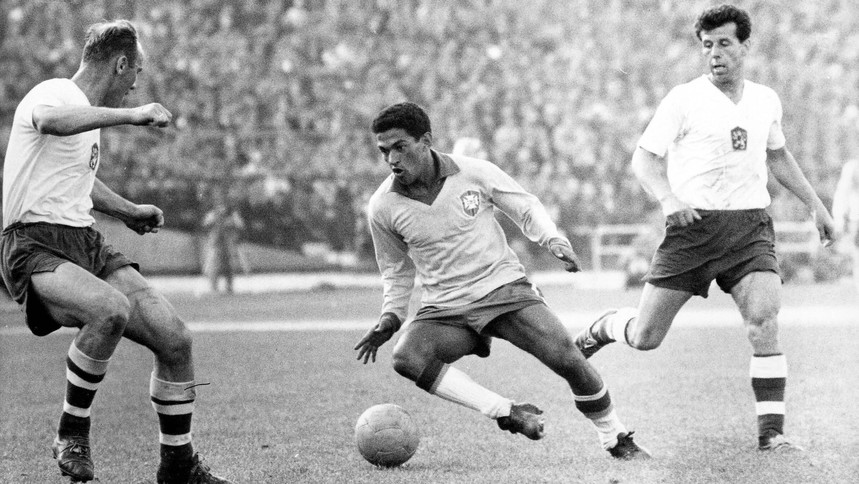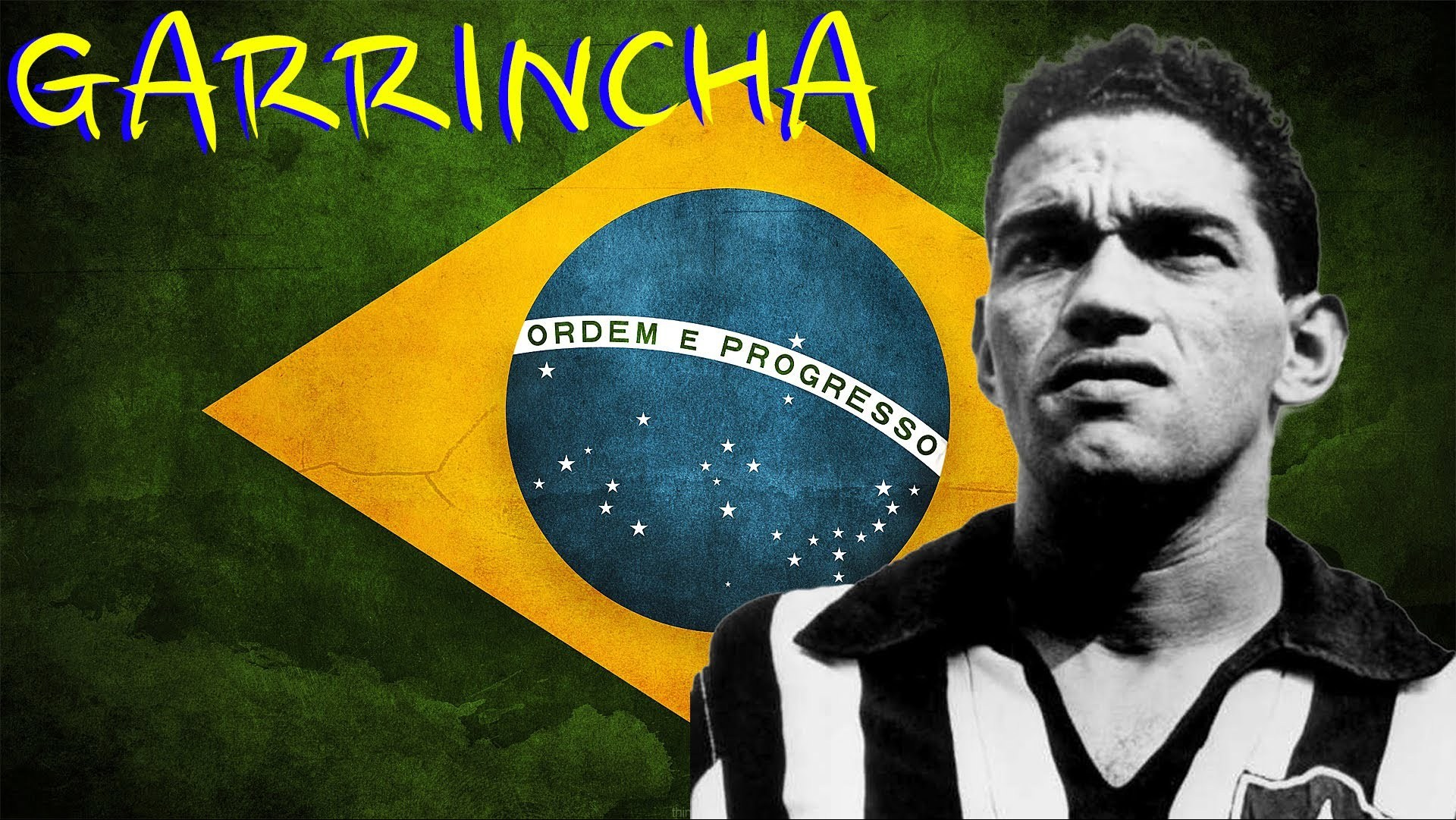
Football’s answer to Charlie Chaplin, Manuel Francisco dos Santos, or “Garrincha” is one of the best examples of ‘being in someone’s shadow’. Garrincha is considered by many as the best player in Brazilian history, but his carefree attitude and distance from the paparazzi meant that he never got what he deserved. And all due to the media bias for one good old pal, Pelé. Pelé was the blue-eyed boy for media, while Garrincha was claimed to be “Joy of People”. He was an exquisite dribbler and had a load full of tricks. He was the true preacher of “Jogo Bonito” or “The beautiful game”.
Garrincha was the beauty of football. Imagine the skills of Ronaldinho, Neymar, Ronaldo or Messi blend into one, and it would be just a part of what Garrincha did. People claimed that it was just like a circus where Garrincha was the ringmaster and the ball was his pet, and he would make his pet do things that left people amazed, wondering and laughing.

Born on 28th of October, 1933 with a slight defect in his left leg, which later earned him the title of “The Bent-Legged Winger”, Garrincha was shorter in height than his compatriots. His sister gave him the name Garrincha, referring to a small brown bird with the same name. He was never too serious about a professional career in football until 20, and even after getting into the professional world showed the least care for the details of the game other than play. He joined Botafogo in Rio de Janerio and dedicated 12 years of his life to the club when he was at the peak of his game. He scored 288 goals in his career, but it was not the numbers that mattered. What mattered was the things he did on the pitch that left the opponents bamboozled and embarrassed. When he was on a trial for Botafogo, he nutmegged Nilton Santos, a Brazilian International defender at the point, showing his extreme skills.
Garrincha is the perfect example of defying the odds. In the 1954 World Cup in Switzerland, the Wankdorf Stadium of Berne, much known for the “miracle of Bern” final, also witnessed the “Battle of Bern” in the quarter-finals between Brazil and the all-powerful Hungary. Garrincha was rejected for the tournament on the basis that he did not fit into the squad that was trying to rebuild itself after the shocker at Maracana in the final of 1950. The media reported that Brazilian style was no more effective, and they must follow the European style of play to succeed. European coaches were appointed and all sorts of stuff done, Brazil could only manage to fall off the tournament after the first knock-out game. They lost 4-2 after a violent game, and returned home empty-handed. The next tournament in Sweden was another test of renovation. Coach Vicente Fiola had some old, experienced and some young, hidden talents in his squad. One of them was this Botafogo winger who had helped his club to the Brazilian league title with 20 goals in 26 games in 1957, that prompted his selection in the Selecao side. The media were not so easy on them, bashing the team selection and philosophy. The campaign began with a victory over Austria before the first goal-less draw of World Cup history with England. In the third game, Fiola handed a debut to two young players due to an injury hit first choice players. While none of them scored against the USSR, a 25 year old Garrincha and 17 year old Pelé formed one of the greatest partnerships to produce “The best 3 minutes of football ever” as the game opened. It marked the beginning of an era for the Brazilians, who would rule the world in the upcoming decade. Brazil went on to win the entire tournament, beating the hosts in the final 5-2, as Garrincha was voted in the Best XI for the World Cup.

But the man was calm and simple as ever. While all his teammates celebrated the victory, Mané Garrincha was furious as he tough the tournament was like a league and Brazil had to face all the teams twice, as in the domestic competitions.
Garrincha was an entirely opposite character off the field. He inherited the fondness for alcohol from his father, and was often found out of his senses in various incidents. Once he even ran over his old man. He put on weight due to his habits, and was eventually dropped for a few games from the national team. He was also too easy in his married life. Married to Nair Marques at the age of 17, he again had an informal marriage to Elza Soares in 1957. Believed to be the father of 14 children, he also had some extra marital relationships on the tours he made with the club.
Then came the year of 1962, the year of Garrincha. He was selected for the World Cup in Chile on the back of some good performances with the club and some old reputation. He was believed to be one of the key players, but when Pelé was injured in a nil-nil draw against Czechoslovakia, the reigns of attack fell on the 29 year old bent legged winger. Garrincha took the opportunity and shone like the brightest star to make the tournament his own. He was so influential on the game that even the best of the opponents looked worse. He scored a brace each in the quarter-final against England and semi-final against Chile and the four goals earned him the Golden Boot. But again, it was not the numbers that mattered, but the fluidity with which he rendered opponents helpless. His heroics earned him not only a place in the team of the tournament, but also the Golden Ball and the Ballon d’or for the year. Brazil beat Czechoslovakia once again in the final to secure the second title for the nation and the winger, which would be his last.

He won a handful of other accolades with his club before the 1966 World Cup in England, but had reached the twilight of his career by then. He was well short of match fitness, and was also suffering a knee injury. The tournament, though, had some surprising “Firsts” of his career despite Brazil being knocked out from the group stages itself. The tournament saw the first game in which Pelé and Garrincha scored together, in a span of a career in which they played together for 8 years, in a 2-0 win over Bulgaria in the first match of the tournament. Garrincha scored an astonishing freekick from outside of his right foot to give Brazil the lead. The next game also saw the first loss for Garrincha in the national colours, losing 1-3 to Hungary at the Goodison Park. He did not feature in the last game against Portugal, and Brazil eventually bowed out with its talismanic playmaker not being able to leave a mark on the world stage.
The 1966 World Cup marked the decline of a wonderful but not hyped career that the man had. He would eventually retire in 1973, on account of becoming a grandfather at the age of 40. He left the world on January 20, 1983 at the age of 49 due to liver cirrhosis. His fondness for alcohol took him to the worthy place of no return.

Garrincha was later recognized in the best world cup team of all time, team of the 20th century, the list of best players of the century and the Brazilian Hall of fame. All these honours did recognize him as one of the best, but he shall always remain a player that was overshadowed in the media due to the limelight that Pelé took. Pelé is often credited for all those World Cup heroics by the public, and the importance of the team behind him is left unnoticed. Garrincha was one such player who deserved more than what he got. His lack of media exposure, innocence towards fame, dedication to the beauty of the game and alcoholic addiction were the reason why the world did not want to portray him as a star. While Pelé got involved in the debate for the best ever and came to be known as the “Black Pearl”, Garrincha always remained “The Forgotten Superstar”. Some people who witnessed the game even believed that he was much, much better player than Pelé, who was more of a finisher, in terms of understanding and effect on the game. The Brazilian authorities named a multi-use stadium in Brasilia, Estádio Mané Garrincha after him. His epitaph was inscribed with the letters “Here rests in peace the one who was the Joy of the People – Mané Garrincha” while paintings on the wall read:
Obrigado, Garrincha, por você ter vivido (Thank you, Garrincha, for having lived).
An example of Garrincha’s dribbling for you to see:
https://drive.google.com/file/d/1WMrHXQOH4D-nlo7RwCsBNkENM-YeAxdR/view?usp=sharing

